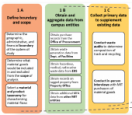
Characterizing the Materials Footprint of a University Campus: Data, Methods, Recommendations
Universities are major consumers and disposers of many materials, but their specific flows are not well characterized. Both energy and material consumption drive a university’s environmental impact. Many universities collect data about their energy consumption (from fuel usage or utility bills) and assess some resulting environmental impacts. However, very little effort has been focused on understanding purchasing, materials handling, and the resulting environmental impacts. To date, there have been few material flow analyses of universities; most analyses concern cities or countries. This paper describes a method for conducting a material flow analysis (MFA) of a university, and it offers the strategies used to obtain first-order characterization and quantification of the flows of the Massachusetts Institute of Technology (MIT).
This case study demonstrates that an MFA of a university requires the use of a portfolio of diverse methods that deliver different outcomes, which then must be pieced together. Inflows and stocks are characterized using financial data, and waste flows are quantified by mass data. Flows are characterized using a combination of product/commodity descriptors and materials.
Material purchases are characterized by product category, temporal variation, purchasing unit/entity, and level of decentralization. The top five purchase categories (by spend) in descending order are: (1) laboratory supplies; (2) hardware purchases/maintenance; (3) laboratory equipment; (4) chemicals, reagents & gases; (5) office furniture. The study also reports the largest stocks of durable goods by quantity and dollar value, as well as the average residence time, or lifetime, of different products. The results also catalogue the quantity and disposal/recycling destinations of different waste streams, including municipal solid waste, single-stream recycling, hazardous waste, medical waste, and radioactive waste.
To estimate the embodied GHG emissions from purchases, spend data was used with an economic input-output life cycle assessment (EIO-LCA). The product categories with the largest embodied emissions were found to be laboratory supplies, chemicals/gases, office furniture, and electronics. The total embodied greenhouse gas emissions of material goods purchased in FY2016 was found to be roughly 78,800 metric tons of CO2-eq. This is significant compared to Scope 1 and 2 emissions. Emissions from waste management were estimated using waste 4 generation figures and EPA’s WARM model; the results indicate that the greenhouse gas impact from waste is much smaller than that from procurement.
This study also reports the findings from sixteen in-person interviews conducted with MIT community members that make purchases. Among other findings, the interviews revealed that purchasers currently have a high level of individual agency and freedom. Purchasers also reported that they would like easily accessible information and guidelines for how to purchase sustainably, as well as formalized incentives for buying more sustainably and conserving materials.
Currently, the purchasing process is carried out independently of any consideration of the materials’ end of life (a linear system, rather than having circularity for sustainability). University entities are autonomous in their purchasing, with some using different systems, which makes complicates the tracking material consumption. This work provides several recommendations for making MFAs easier to perform at the university-level and for reducing the materials and carbon footprint of a research universities. Some key recommendations include: centralizing data collection and storage on procurement and waste; requiring more detailed product-level data from vendors; and creating web-based interdepartmental sharing programs for material goods.
--
Rachel joined the Office of Sustainability in September 2016 as a Student Fellow. In her role, she helped identify opportunities for MIT to reduce its environmental impact via reducing its materials footprint. Rachel completed her PhD with MIT's Institute for Data, Systems, and Society in 2020. Her dissertation closely aligns with her work with MITOS. Working with MITOS and the Environmental Solutions Initiative, she studied material flows at MIT as a case study to understand better the fundamentals of material consumption and waste management of universities situated in a larger urban context.


